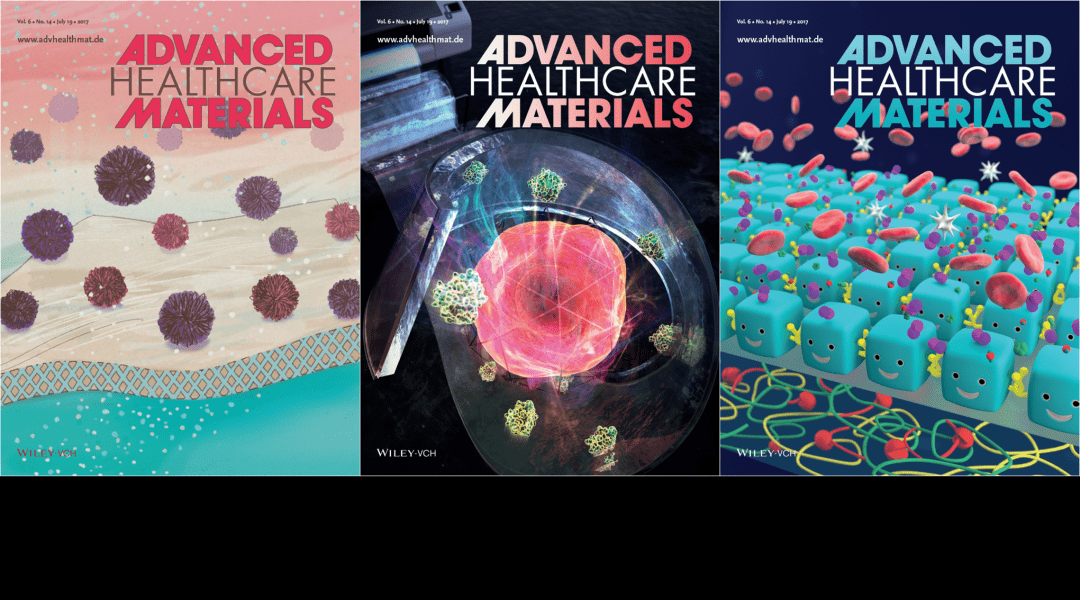Advanced Healthcare Materials celebrates its 5th birthday this year! Since 2012 we have been bringing you the latest breakthroughs in biomedical materials science with a strong focus on improving human health, and we will continue to do so in 2017. Read more about this in our latest editorial.
No access to our published content yet? Make sure to recommend Advanced Healthcare Materials to your librarian. More information can be found here.
In this biweekly feature, we highlight the artwork on the covers of the most recent issue of Advanced Healthcare Materials, and of course the research behind it. You can find this week’s issue here. Click on the titles or cover images below to get to the corresponding papers. Also check out our monthly Most Read here.
Moonhyun Choi, Hee Ho Park, Daheui Choi, Uiyoung Han, Tai Hyun Park, Hwankyu Lee, Juhyun Park, and Jinkee Hong
A system to fabricate multilayered nanofilms with inkjet printing has been developed by Jinkee Hong from Chung-Ang University in Seoul and co-workers from this and other universities in Korea. These inkjet-printed nanofilms are composed of both polymeric and bioactive materials, and for instance can be used to enhance the structural stability of the basic fibroblast growth factor. Such nanofilms containing growth factors are effective for undifferentiated pluripotent stem cells by promoting proliferation and expansion.
Mi Hu, Hao Chang, He Zhang, Jing Wang, Wen-xi Lei, Bo-chao Li, Ke-feng Ren, and Jian Ji
Endothelial cells play key roles in physiology and pathology. Ke-feng Ren and co-workers from Zhejiang University in Hangzhou, China report on a surface with mechanical adaptability, which is based on a thin polyelectrolyte film that can respond to cell-secreted matrix metalloproteinases. The results demonstrate that such a system is superior compared to the state of art in promoting endothelial cell growth and functionality.
Nicolas Marets, Daniel Kuo, Jason R. Torrey, Takeshi Sakamoto, Masahiro Henmi, Hiroyuki Katayama, and Takashi Kato
For the first time, a liquid-crystalline composite membrane for the filtration of viruses during water treatment is reported by Takashi Kato, Hiroyuki Katayama, and co-workers from the University of Tokyo in Japan. The self-assembling liquid crystals can form a uniform nanostructured bicontinuous cubic separation layer, which minimizes the number of defects and thereby shows more than 99.9999% removal of the virus. This development may spark more innovative designs for future membranes for water treatment.
Interested in more news about Advanced Healthcare Materials? Also check out our monthly Most Read here.


 Nanofilms via Inkjet Printing for Stabilizing Growth Factor and Designing Desired Cell Developments
Nanofilms via Inkjet Printing for Stabilizing Growth Factor and Designing Desired Cell Developments Adaptability of the MMP-Responsive Film Improves the Functionality of Endothelial Cell Monolayer
Adaptability of the MMP-Responsive Film Improves the Functionality of Endothelial Cell Monolayer Efficient Virus Rejection with Self-Organized Membranes Based on a Crosslinked Bicontinuous Cubic Liquid Crystal
Efficient Virus Rejection with Self-Organized Membranes Based on a Crosslinked Bicontinuous Cubic Liquid Crystal














